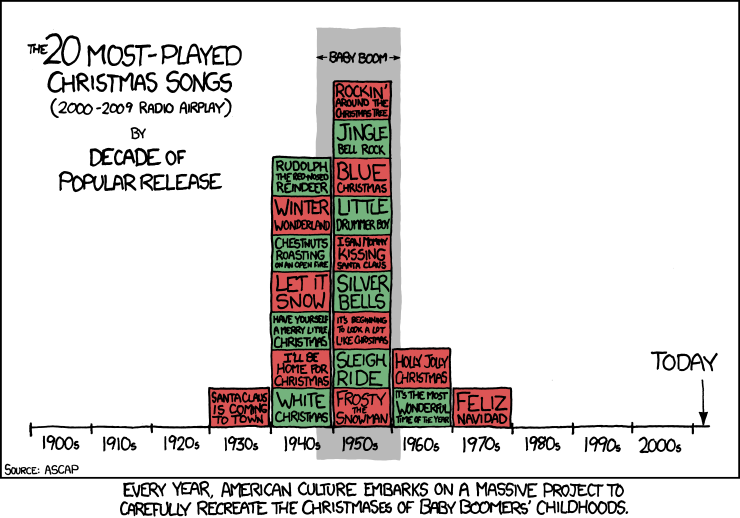The Most Repetitive Time of the Year

"Joy to the World" was written in 1719. "Silent Night" is from 1818. "Jingle Bells" was first heard in 1857. "Here Comes Santa Claus" found its way into the world in 1934. "Holly Jolly Christmas" came around in the mid 1960s. But to anyone born after 1970, these songs have all existed for their entire life, so there is really no distinction to be made in point of origin. It's a little bit difficult for me to fathom that there ever was a time when people would have known "Joy to the World" but not "Silent Night." It's even odd to consider that there was a time when kids would have sang about Rudolph without ever having heard of Frosty.
As the graphic above points out, out culture has canonized, codified, and now closed off its Christmas standards. While there was a boom in additions to the Christmas canon during the middle part of the 20th Century, by 1970 we'd reached a critical mass. That year's "Feliz Navidad" became the final entry. (Though first John Lennon and Yoko Ono and then Bob Geldof and Midge Ure have found a bit of a backdoor to inclusion by coming up with a subgenre of Christmas protest songs).
The caption on the graphic takes a cynical view of the matter, theorizing that the reason we have a frozen canon is because Baby Boomers are looking to constantly replicate their childhood experiences. While I don't doubt that the American Christmas is a nostalgia-driven phenomenon, I don't think it's just Boomers that are imposing this replication on subsequent generations. The Xers and Millenials are apparently all too content to adopt the same standards, without demanding any new additions themselves.
But why then did we have a time period where we suddenly did see an explosion of new Christmas songs? Many will notice the secularization of the holiday in the titles in the graphic above. And the process of commodifying Christmas began in earnest right around this time (for example, Rudolph was created by a department store chain in 1939). In moving the center of the holiday from the church to the shopping mall, it would stand to reason that a song like "It's Beginning to Look a Lot Like Christmas" would assuage the guilt and encourage the consumerist impulses of the holiday shopper. Whereas "Gentle Mary Laid Her Child" might inspire one to quiet reflection, a center of commerce would rather the customer be inspired to different impulses in hearing "Rockin' Around the Christmas Tree." And you might regard the inclusion of Santa Claus in any song as a code for "toys and goodies"--i.e. "Toys and Goodies are Coming to Town," or perhaps "I Saw Mommy Kissing Capitalism."
And the other obvious factor that led to the popularization of those songs of the mid-20th Century was the rise of mass media. Many of those songs were first introduced to society in films. Many wouldn't have been created in the first place if not for the demands of the (then) new media. If Bing Crosby had been born 50 years earlier (or 50 years later), nobody would care if we had a white Christmas, but because he was born in 1903 and was at his career peak during the golden age of radio, meteorology this time of year is placed under increased scrutiny.
In light of these factors, it's not surprising to me that our holiday soundtrack is stagnant. The novelty now is only to be found in anticipating what artist will release a Christmas album and what particular songs they will record. And certainly now that our monoculture has been smashed by the World Wide Web, I don't anticipate ever living to see a radical alteration of the increasingly entrenched roster of standards. But I'll try not to let it get me down. I'd rather not have a Blue Christmas.
Tweet

0 Comments:
Post a Comment
<< Home